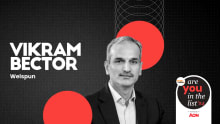It is a ‘Hit Refresh’ scenario: CHRO, Sony Pictures Networks India

Leading the way in a candid conversation with People Matters, Manu Wadhwa, Chief Human Resource Officer, Sony Pictures Networks India (SPN), reflected on some of the key leadership lessons that guided her in her journey so far and highlighted the key leadership traits essential to survive and thrive in the digital age.
With over two decades of experience in the human resources function across various industries and countries, Manu has piloted workplace and people agenda of globally dynamic organizations like GE and American Express. Her expertise lies in Organization Design & Effectiveness, Talent & Development, HR Transformation, Change and Digital Innovation. Interestingly, she started her career in 1996 in Tata Unisys as a financial analyst.
An alumni of SCMHRD, Pune and the GE Human Resources Leadership Program (#HRLP), Wadhwa is a member of the Confederation of Indian Industry (CII) – National Leadership & HR Committee, Society for Human Resources Management (SHRM) – Asia Pacific Advisory Board, Chandigarh University Corporate Advisory Board as well as the Jombay Think Tank Forum.
Read on to know why Wadhwa emphasizes agility, her advice for talent leaders as they navigate through the digital storm and what was the trigger for her shift from finance to HR.
In the early years of your career, what triggered the move from finance to HR?
Since childhood, I was drawn towards taking up roles, which enabled people in my ecosystem to thrive and prosper and bring out their best selves in whatever they did. However, given the natural career choices expected from a family of entrepreneurs – I took up my first job in finance/ accounting at Tata Unisys. While interacting with students, who would be considering course choices in technology, very soon, I realised that my natural passion thrived in counselling them towards making the right career choices. This was the tipping point for me to further my education as well as building a career in human capital management.
What are some of the leadership lessons that guided you in your journey so far? Who is the one leader you look up to?
I have been blessed to have worked with the best minds, across the world, who have acted as a constant source of inspiration and motivation. Some of the key learnings that have stayed with me are:
- Leaders should harness the power of teams through connecting individual’s own purpose/s to organizational goals
- Trust & Empowerment can be the biggest sources of driving exponential results and excellence in teams
- Encourage your teams to fail; share their learnings from it and move on. In a nut-shell – fail fast, recover faster
- Be the best version of yourself. Tap into your inner potential and wear your individual identity with confidence every day.
Considering the current pace of things that are impacting the world of work, what are the three key qualities that leaders should have?
In this age of Industrial Revolution 4.0, rapid technological and workforce composition change means an increasing number of sectors are approaching a tipping point at which companies must become agile to compete and survive. There is an increasing need to transform internally as well as externally by being consumer and employee centric, and at the same time efficient and profitable.
To form and lead an agile transformation successfully, leaders need a new approach. The mind- sets and skills they have carefully honed over years of experience are necessary but not sufficient to lead 21st-century organizations.
In my view, to lead agile transformation, the key capabilities leaders need are:
- Agility: Being aware of the surrounding ecosystem and espousing a more creative mind set to change, which fosters innovation and value creation as opposed to solving for business exigencies.
- Self-Awareness & Development: Being holistically focussed, proactive in maintaining relationships and keeping abreast with times, technology savvy and reverse mentoring are essential. It begins with embracing your ignorance and being a learner/student throughout one’s life
- Collaborative Mind-set: Instil and work with a sportsman demeanour. Identify common strengths and rally the teams around/join the forces to win.
It is all about developing relational expertise, creating conditions for effective teamwork, breaking silos and solutioning for the unknown.
Having worked with global organizations like Sony Pictures, Coca-Cola, American Express, GE, among others, what are some of the recurring workforce concerns you have encountered?
I would like to term these as challenges and opportunities. Following are the key recurring factors:
Accessing talent: Recruiting the right talent with apt skills and culture fit. It has been about mobilizing and leveraging internal resources though planned internal movements, finding talent from across industries and strategically leveraging technology to augment sourcing and boost recruiting productivity. In recent years, it’s also been a lot about leveraging talent in the alternative workforce to meet the ever changing talent demands across businesses.
Employee Engagement: The high correlation between employee engagement and business results is often witnessed to be validated. However, one size does not fit all and what may work in one organisation/group may not work in another. Additionally, in today’s day and age of extreme consumer focus, the internal consumer expects a similar experience it receives from the best in class product/ service organisation – hyper personalized.
Productivity: Each organization at various phases of evolution/ maturity, has the need to evaluate its processes and structures to look for efficiency to build meritocratic teams. The solutions can range from intensive studies and application of six sigma methodologies or to simpler tactics like training or basic solutions like boosting team morale.
However, keeping a laser sharp focus on these is critical as the real competitive advantage in any business comes from people.
You cannot win with product/ strategy alone, it’s the contribution of people behind the scenes who make it a winning product/strategy.
How can leaders build a scalable culture that can be replicated across geographies?
Leaders need to have an ear to the ground, listen to people and take care of their needs. It all begins with ‘raison d'être’ - the reason for being. Since the ‘why’ is clear, even with growth in numbers or geographies, the culture would percolate. When it comes to ensuring it permeates consistently and stays, some rules of thumb work invariably.
- Tell stories: Stories have the power, to help imagine, inspire people and re-live experiences.
- Reward Right behaviour: Reinforcement comes well if the right behaviours are rewarded and employees feel appreciated for their contribution
- Consistent Communication: Across levels and geographies, use opportunities beyond hiring and orientation to talk about culture. Ingrain it in organisation policies, processes and interventions.
- Be Inclusive: While culture is defined into expected values and behaviours, it still needs to be flexible and have scope to adapt for nuances in businesses and, be sensitive and inclusive of cultural diversity
What would your advice be for talent leaders as they strive to build a digital workforce?
The key word in today’s environment is Agile.
- Agile Leadership: Since, one cannot predict the future, being proactive can help us in being prepared for the future
- Agile teams: While relying on a stable foundation organization structure, it is important to work towards building non-traditional, non-hierarchical swarm teams which will ensure scalability and flexibility
- Agile Learning: Getting personalised learning and building models of lifelong learning which incentivize and motivate employees to invest in developing new skills
While the above is important, one key message would be to not lose your sanity in this time of supersonic change.
What is your take on the long-term impact of AI and other emerging technologies on jobs, people and the future of work?
When it comes to Work: Jobs, Workforce: People and Workplace: Where work is performed; from physical places to virtual collaboration networks, it is a ‘Hit Refresh’ scenario
At the cost of sounding repetitive, ‘Junk the Job description’, it is already time that we look at skills and experiences gathered beyond job titles. As predicted, AI would lead to creation of more, however different jobs. In the long- term, jobs would become ‘Super jobs’- jobs that need to focus on the human dimension of work and AI would be able to provide significant productivity gains.
The Next Gen workforce will need to embrace this rapid change and also upskill to understand AI driven technology and be prepared for the redesigned roles.
What are your top priorities moving towards industrial revolution4?
It is a great time to be in the workforce when we are transitioning to Industry 4.0. We are witness to the changes that are transforming organizations, and as leaders responsible for managing the ambiguity and volatility with speed and agility.
Refresh: Leadership Context: My focus as a member of the leadership team, is to leverage our collective ability to develop and foster organization performance. It’s about how we as leaders can combine our experiences and traditionally seek expectations with new leadership competencies to help our organization pursue success and work on more integrated solutions.
Rewire: The way we work: Collaboration is multiplication, the need for cross pollination for solutioning is the way to work. New mind-sets and technologies are easing the shift to new team-based models of work. The focus is to build on talent practices and behaviours that fully support a team-based operating model.
Reimagine: Engagement & Learning: Changing demographics, employee expectations and the war for most talent has challenged organizations to appeal to the most in- demand and diverse workforce. What we are focusing on is curating new and hyper- personalized experiences, movement within and between jobs and non- linear career portfolios to appeal to talent. Also, new models of life-long learning where we look at alternative forms of learning for the workforce should be geared up for the new roles which will help bring purpose to work.









